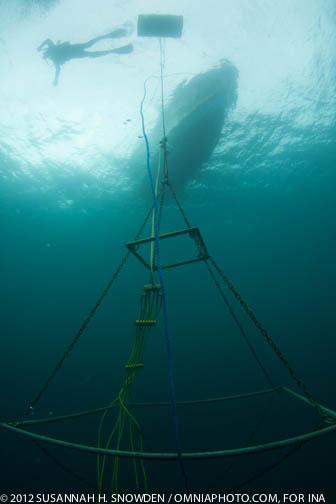With only a handful of days remaining to us, the team has prioritized tasks and approached the site with surgical precision. Between days of intense weather (including cyclone warnings!) and varying visibility on site, we have made the most of the time we can get underwater. Two teams have been set with the task of measuring in all the datum points; these measurements will be used to create a three-dimensional site plan. Everyone else has been assigned a portion of the grid to excavate. For this season, it was decided to test two key areas of the site – to the south and to the east of the main concretion. Both areas have yielded large quantities of artifacts – mainly large jars and other pottery finds – but the southern portion has also yielded glass ingots, stone querns (grinding stone in the shape of a small stone bench), and a lamp.

One of the querns (artifact shaped like a small stone bench used for grinding grains) found on site. Photo by Susannah H. Snowden.
For two of our team members – Kevin Melia-Teevan and Arianna DiMucci – this has been their first experience with underwater archaeology. I chatted recently with Kevin, a second year PhD student in the NAP program at TAMU, about his reactions to excavating 110 feet below the ocean’s surface. As this is my fourth underwater archaeological site, our conversation reminded me of my own experiences at the Bajo (another INA project and my first underwater archaeology experience). For those unfamiliar with the working conditions on underwater sites, his impressions offer some insights into the unique experience of submerged archaeology. One of the most noticeable advantages to underwater excavation that Kevin mentioned is the range of motion available to the archaeologist suspended in the water column; we are able to hover weightless over our work area. Furthermore, with every ascent and descent to the site, the excavator gets an aerial view and is able to see how their own personal excavation square relates to the site as a whole (something not always easy to ascertain on terrestrial excavations). As with many archaeologists transitioning from terrestrial sites, the time constraints of underwater excavation are the most frustrating aspect. Also, he noted that while weather conditions affect terrestrial sites, the range of factors for an underwater site (tides, visibility, current, as well as storms) are particularly daunting. This season we have certainly dealt with our fair share of all these factors! However, as Kevin made sure to note, just 50 years ago this site would not have been accessible to the archaeologist at all!
As we move into the final days of this excavation season, we continue to battle time and the elements, but we are encouraged by each day’s discoveries.
/files



